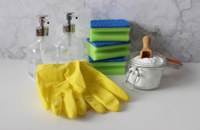Prairie Fare: Spring cleaning can make kitchens safer
(Click an image below to view a high-resolution image that can be downloaded)
“When are we going to make soap?” I asked my mother.
“One of these days, we will make soap,” she responded.
I was quite persistent and asked almost every day. I was too young to be in school and a bit bored.
I thought we were going to make some pleasant-smelling bath soap with voluminous bubbles. I didn’t know that the homemade mixture might have removed my skin.
Finally, the big soap-making day came. Mom opened all the windows on that spring day.
Soap making involved boiling tallow (fat) and lye. I was sent outside for fresh air, and I stayed outside. I never asked about making soap again.
That somewhat slimy brownish soap really worked in cleaning the scuffs from my tennis shoes, though. We had enough “homemade soap” for many years.
According to the Cleaning Institute, soap making dates back thousands of years and involved boiling fat with ashes long ago. Soap making became an art in European countries such as Spain and Italy. The European soap makers often used oil extracted from olives.
Overall cleanliness fell out of fashion during the Middle Ages in many parts of the world. Diseases eventually began to be associated with lack of cleanliness. In Japan and Finland, however, regular bathing and saunas, respectively, were popular.
Later, “detergents” were invented. While “soaps” are natural products made from animal or vegetable fat, detergents were invented by chemists. Most of the soaps we use today actually are detergents.
As we know, entire aisles in retail stores are dedicated to various cleaning products.
Cleaning agents are complex. Read the list of ingredients for a lesson in chemistry. Products might include “builders” to prevent minerals in your water from interfering with the actions of the detergent so your dishes and glasses do not have streaks. Many detergents, including dish detergents, have colorants or fragrances as ingredients, along with their active agents.
As we enter spring, many people refresh their homes by doing some cleaning. Kitchens, in particular, can harbor pathogens (disease-causing organisms) because of the wide range of foods we prepare.
Bacteria love to grow in high-moisture, high-protein foods, and some types of bacteria can linger on surfaces. If we do not clean kitchen surfaces and cleaning cloths effectively, germs can be spread around our kitchens.
Cleaning and sanitizing are different processes. Cleaning removes visible soil (including food particles) and other contaminants from surfaces. “Sanitizing” reduces the amount of bacteria and other germs on surfaces. Chemical agents (chlorine solution) or the hot water cycle in a dishwasher can sanitize.
Surfaces such as counter tops, cutting boards and sinks, should be cleaned then sanitized with a chlorine bleach-water mixture or other suitable sanitizer, especially if raw meat has contacted the surfaces. Read the fine print on the product labels for appropriate amounts to use and any protective equipment or ventilation needed.
A 20-second handwashing process is critical before, during and after preparing food. The “soap” we use to clean our hands likely is a detergent.
These tips are based on information from the Partnership for Food Safety Education and other sources to focus your efforts in a home kitchen where they matter the most.
- Be sure to wash cloth rags and towels in the hot cycle in your washing machine. Towels and sponges can be breeding grounds for bacteria. Paper towels are an option for wiping kitchen surfaces and drying your hands.
- If you like sponges, change them at least every couple of weeks. The Good Housekeeping Institute recommends soaking sponges in a mixture of 3/4 cup of bleach per gallon of water for five minutes. This process will kill 99.99% of three strains of bacteria, according to their research.
- Clean your refrigerator frequently. Experts recommend a once-a-week cleaning using hot water and soap on a soft cloth or paper towel to wipe spills. Avoid using chlorine bleach or abrasives that might harm the gaskets in your refrigerator.
- Clean your sink, drain and disposals regularly. Bacteria can grow in a disposal unit, but you can kill bacteria with a solution of 3/4 teaspoon of unscented chlorine bleach per quart of water poured down the drain.
- Don’t forget to clean the microwave at home or at work. Partially fill a microwave-safe bowl with water, place in the microwave oven and heat on high for about 4 minutes. After this steaming, use a mixture of hot water and dish detergent to wipe the surfaces. Then dry with a paper towel.
I always feel some satisfaction after cleaning an area of our home. When cleaning your cupboards or refrigerator, you may find some ingredients to use in these muffins. The beans are rich in fiber, and in most recipes, you can substitute up to half of the white flour with whole-wheat flour.
Apple Cinnamon Muffins
2 (15.5-oz.) cans Great Northern beans, drained and rinsed
1/3 cup low-fat milk
1 cup sugar
¼ cup butter (or substitute your favorite oil)
3 eggs
2 teaspoons vanilla extract
1 cup all-purpose flour
1/2 cup whole-wheat flour
1 teaspoon baking soda
1/2 teaspoon salt
4 teaspoons cinnamon
1 large apple, peeled, finely chopped
Process beans and milk in a food processor or blender until smooth. Mix sugar and butter (or oil) in a large bowl; beat in eggs and vanilla. Add bean mixture, mixing until well blended. Mix in flours, baking soda, salt and cinnamon. Gently mix in apples. Spoon mixture into 16 greased or paper-lined muffin tins. Bake at 375 F for 20 to 25 minutes. Cool on wire racks.
Makes 16 servings. Each serving has 180 calories, 4 grams (g) fat, 5 g protein, 32 g carbohydrate, 4 g fiber and 190 milligrams sodium.
Julie Garden-Robinson, Ph.D., R.D., L.R.D., is a North Dakota State University Extension food and nutrition specialist and professor in the Department of Health, Nutrition and Exercise Sciences. Follow her on Twitter @jgardenrobinson)
NDSU Agriculture Communication – April 6, 2023
Source: Julie Garden-Robinson, 701-231-7187, julie.garden-robinson@ndsu.edu
Editor: Elizabeth Cronin, 701-231-7881, elizabeth.cronin@ndsu.edu




